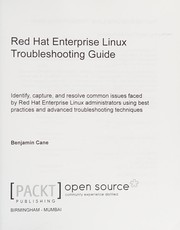Check nearby libraries
Buy this book

This edition doesn't have a description yet. Can you add one?
Check nearby libraries
Buy this book

Previews available in: English
Showing 1 featured edition. View all 1 editions?
| Edition | Availability |
|---|---|
|
1
Red Hat Enterprise Linux troubleshooting guide: identify, capture, and resolve common issues faced by Red Hat Enterprise Linux administrators using best practices and advanced troubleshooting techniques
2015, Packt Publishing
in English
1785287877 9781785287879
|
aaaa
Libraries near you:
WorldCat
|
Book Details
Table of Contents
Cover; Copyright; Credits; About the Author; About the Reviewers; www.PacktPub.com; Table of Contents; Preface; Chapter 1: Troubleshooting Best Practices; Styles of troubleshooting; The Data Collector; The Educated Guesser; The Adaptor; Choosing the appropriate style; Troubleshooting steps; Understanding the problem statement; Asking questions; Attempting to duplicate the issue; Running investigatory commands; Establishing a hypothesis; Putting together patterns; Is this something that I've encountered before?; Trial and error; Start by creating a backup; Getting help; Books
Team Wikis or RunbooksGoogle; Man pages; Red Hat kernel docs; People; Documentation; Root cause analysis; The anatomy of a good RCA; The problem as it was reported; The actual root cause of the problem; A timeline of events and actions taken; Any key data points to validate the root cause; A plan of action to prevent the incident from reoccurring; Establishing a root cause; Sometimes you must sacrifice a root cause analysis; Understanding your environment; Summary; Chapter 2: Troubleshooting Commands and Sources of Useful Information; Finding useful information; Log files
The default locationCommon log files; Finding logs that are not in the default location; Configuration files; Default system configuration directory; Finding configuration files; The proc filesystem; Troubleshooting commands; Command-line basics; Command flags; The piping command output; Gathering general information; w
show who is logged on and what they are doing; rpm
RPM package manager; df
report file system space usage; free
display memory utilization; ps
report a snapshot of current running processes; Networking; ip
show and manipulate network settings
Netstat
network statisticsPerformance; iotop
a simple top-like I/O monitor; iostat
report I/O and CPU statistics; vmstat
report virtual memory statistics; sar
collect, report, or save system activity information; Summary; Chapter 3: Troubleshooting a Web Application; A small back story; The reported issue; Data gathering; Asking questions; Duplicating the issue; Understanding the environment; Where is this blog hosted?; Ok, it's within our environment; now what?; What services are installed and running?; Looking for error messages; Apache logs; Verifying the database
Verifying the WordPress databaseEstablishing a hypothesis; Resolving the issue; Understanding database data files; Finding the MariaDB data folder; Resolving data file issues; Validating; Final validation; Summary; Chapter 4: Troubleshooting Performance Issues; Performance issues; It's slow; Performance; Application; CPU; Top
a single command to look at everything; Determining the number of CPUs available; ps
Drill down deeper on individual processes with ps; Putting it all together; A quick look with top; Memory; free
Looking at free and used memory; Checking for oomkill
Ps
Checking individual processes memory utilization
Edition Notes
Includes index.
Classifications
The Physical Object
ID Numbers
Community Reviews (0)
Feedback?| August 17, 2022 | Edited by ImportBot | import existing book |
| May 18, 2022 | Created by ImportBot | import new book |









